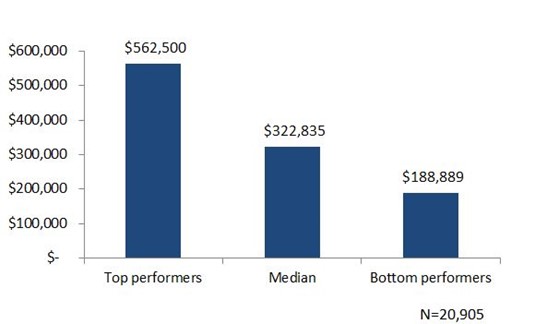Employee productivity is closely linked to organizational revenue. But how much revenue should each employee be expected to generate?
By Perry D. Wiggins and CPA
December 5, 2018

When organizations make hiring decisions, they’re counting on the people they bring onboard to be well worth the investment. Whether an employee is in a revenue-generating role or serving in an administrative or support capacity, the ratio of revenue generated to each employee can be a key indicator of how productive and efficient the organization is as a whole.
For this month’s metric, we examine business entity revenue per business entity employee, as compiled by APQC’s Finance Organization Open Standards Benchmarking® survey. The 20,905 responses were pulled from a variety of surveys across multiple organizational functions. The calculation used for this metric is the total annual business entity revenue for the period when the survey was completed, divided by total business entity employees.
Among the top 25% of organizations that are considered the best performers on this metric, annual revenue per business entity employee is $562,500 or more. Among the bottom 25%, revenue generated per employee is $188,889 or less. At the median are the organizations bringing in $322,835 in revenue per employee each year.
According to the U.S. Bureau of Labor Statistics, a median full-time employee’s pay is $887 a week, or $46,124 annually. If you add a 30% benefits load to cover the employer share of Social Security and Medicare, unemployment insurance, workers’ compensation coverage, healthcare insurance premiums, and pension costs, the cost of each employee grows to about $60,000.
At a median organization, per the metric above, such an employee would bring the company a bit more than five times the amount of his or her pay in annual revenue. In other words, that employee’s job would pay for itself five times over.

Business Entity Revenue Per Business Entity Employee
Of course, salary ranges and revenue can vary wildly depending on industry and business model. Regardless of how large that ratio can potentially be, every manager’s challenge is to ensure each employee’s contributions more than cover the cost of his or her employment, or even better, generate a healthy profit.
At the same time, each company has to have the right brainpower for its business model. Due to the nature of our work at APQC, for example, we have a large percentage of highly skilled employees with advanced degrees. Because the cost of such labor is high, we are careful to use those resources wisely to ensure the continuity of our organization. The key here is maximizing the productivity of our human resources — especially those whose credentials come at a premium cost.
Measuring Productivity
Organizations should examine their industry-specific view of revenue per employee. Those that fall into the bottom half on this metric may need to take a hard look at overhead and resource allocation, ensuring the balance of administrative and revenue-generating positions is appropriate. In addition, they need to check that all employees have the tools to maximize productivity.
To optimize productivity and increase revenue, an organization first has to start measuring and tracking the key performance indicators (KPIs) of employee productivity. Selecting the right KPIs can help an organization prioritize work, align work with overall organizational strategy, and measure progress toward established targets.
At many organizations, tracking, analyzing, and reporting KPIs is the finance team’s responsibility.
Choosing the right KPIs is a critical first step in the successful deployment of most performance management systems. These include balanced scorecard-type systems, which typically examine KPIs from four perspectives: financial, customer, internal, and learning. They also include lean management systems, which focus on eliminating waste, and quality-management approaches, such as using the seven categories from the Malcolm Baldrige National Quality Award.
KPIs not only help track employee and organizational performance, they identify areas for improvement and help monitor progress toward both short and long-term goals.
By establishing performance measurement systems and tracking KPIs, organizations can ensure they make the most of each employee’s time, knowledge, and experience. By maximizing employee productivity, an organization can move closer to the top-performer category in terms of revenue generated per employee.
